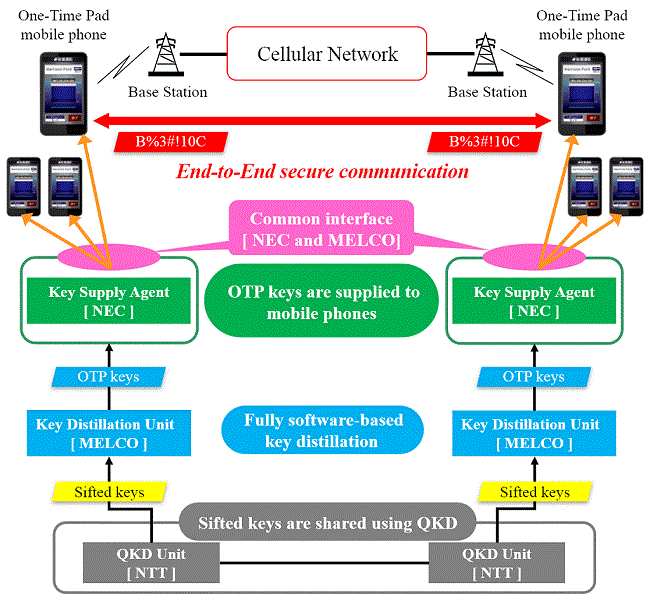
Subject A : QKD network control technology
157A-T01Application-enhanced QKD systems
Mitsubishi Electric Corporation (Mitsuru Matsui)
To establish secure photonic network using QKD technology, QKD system needs to continuously generate crypto-key at a high speed and low cost under ensured security. On the other hand, enhancement of application based on QKD system is also necessary. To achieve the above purposes, we set following two subthemes.
- Subtheme 1: Stabilization technique
- We proposed a new and efficient key distillation algorithm by improving the existing security proofs of quantum cryptography. We also implemented it as a software and are demonstrating its performance; particularly the speed and the stability.
- Subtheme 2: Enhancing application platform
- Our aim is to develop new mobile phone software on Android® Devices which enables secure communication between smart phones using keys shared by QKD. This application makes eavesdropping on calls impossible by using One-Time Pad Encryption. In addition, we carry out field tests of this application to verify the operational stability.
- Subtheme 1: Stabilization technique
- We developed a new and high-speed key distillation software for quantum cryptography. We are continuing to demonstrate its performance within the Tokyo QKD Network, i.e., by distilling sifted keys from the DPS-QKD device on a real-time basis.
- Subtheme 2: Enhancing application platform
- We ported the "One-Time Pad mobile phone system" which is developed before this project to Android® Devices, and implemented a key acquisition functionality based on common interface for key supplying from QKD examined with NEC. Furthermore, to make calls of this system more stable, we evaluated call quality in the field test and confirmed sufficient quality of calls within cellphone range.
- Subtheme 1: Stabilization technique
- "High-speed and stable key distillation software"
 Fully software-based implementation
Fully software-based implementation Applied theoretical outcome of "Subject 157B-T01"
Applied theoretical outcome of "Subject 157B-T01" Real-time basis key distillation
Real-time basis key distillation- Subtheme 2: Enhancing application platform
- "One-Time Pad mobile phone system"
 Implemented as Android® smartphone application
Implemented as Android® smartphone application OTP keys are supplied to mobile phones by using common interface
OTP keys are supplied to mobile phones by using common interface Sufficient quality of calls within cellphone range
Sufficient quality of calls within cellphone range
Fig. 1System overview
Final results for Team 157A-T01
| Task title | Outcome | Date | Note |
|---|---|---|---|
| 1: High-speed and stable key distillation software | Improved key rates by improved security analysis (Finite size analysis, hash function) | Sep. 2012 Jun. 2013 |
NJP 14 (2012) 093014 IEEE Trans. IT 59, 4700 (2013) |
| Fully software-based key distillation (EC with HARQ, PA with FFT algorithm ) | Mar. 2012 | ISEC2010-121 | |
| Software implementation for DPS-QKD | Mar. 2014 | ||
| Real-time basis key distillation for DPS-QKD | Mar. 2015 | ||
| 2: One-Time Pad mobile phone system | Conceptual design | Mar. 2013 | |
| Ported software to Android® OS | Oct. 2013 | prototype | |
| Design common key supply interface | Oct. 2013 | examined with NEC | |
| Stabilized quality of calls within cellphone range | Mar. 2014 | ||
| Confirmed sufficient quality of calls within cellphone range | Mar. 2015 |
- Subtheme 1: Stabilization technique
- "Efficient key distillation algorithm"
- Our results verified that the entire process of the key distillation can actually be performed solely by a software on a PC, although it had previously been thought to require a dedicated hardware such as FPGA boards. We hope to apply these results to other QKD devices, such as the BB84 by NEC and the CVQKD by Gakushuin Univ.
- Subtheme 2: Enhancing application platform
- "Development of mobile phone software"
- We developed a new mobile phone software which makes eavesdropping on communication impossible using QKD. Furthermore, we examined a common interface for supplying keys to a software from a QKD with NEC, and implemented a key acquisition functionality in our software based on this interface. Our future issues are both to establish methods of measuring communication disruption to clarify the condition of good call quality, and to extend applicability of this system other than to mobile phones.

